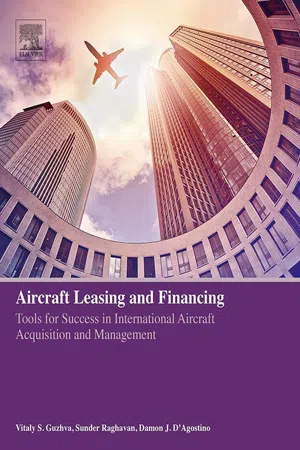
Aircraft Leasing and Financing
Tools for Success in International Aircraft Acquisition and Management
- 526 pages
- English
- ePUB (mobile friendly)
- Available on iOS & Android
Aircraft Leasing and Financing
Tools for Success in International Aircraft Acquisition and Management
About this book
Aircraft Financing and Leasing: Tools for Success in Aircraft Acquisition and Management provides researchers, industry professionals and students with a thorough overview of the skills necessary for navigating this dynamic field. The book details the industry's foundational concepts, including aviation law and regulation, airline credit analysis, maintenance reserves, insurance, transaction cost modeling, risk management tools, such as fuel hedging, and the art of lease negotiations. Different types of aircraft are explored, highlighting their purposes, as well as when and why airline operators choose specific models over others.In addition, the book also covers important factors, such as maintenance reserve development, modeling financial returns for leased aircraft, and appraising aircraft values. Most chapters feature detailed case studies, applying concepts to actual industry circumstances. Users will find this an ideal resource for practitioners or as an outstanding reference for senior undergraduate and graduate students.- Presents the foundations of aircraft leasing and financing, including aviation law and regulation, airline credit analysis, maintenance reserves, insurance, transaction cost modeling, and more- Provides an overview of the different types of aircraft, their purposes, and when and why operators choose specific models over others- Offers a blend of academic and professional views, making it suitable for both student and practitioner- Serves as an aircraft finance and leasing reference for those starting their careers, as well as for legal, investment, and other professionals
Frequently asked questions
- Essential is ideal for learners and professionals who enjoy exploring a wide range of subjects. Access the Essential Library with 800,000+ trusted titles and best-sellers across business, personal growth, and the humanities. Includes unlimited reading time and Standard Read Aloud voice.
- Complete: Perfect for advanced learners and researchers needing full, unrestricted access. Unlock 1.4M+ books across hundreds of subjects, including academic and specialized titles. The Complete Plan also includes advanced features like Premium Read Aloud and Research Assistant.
Please note we cannot support devices running on iOS 13 and Android 7 or earlier. Learn more about using the app.
Information
Overview of the Aircraft-Leasing Industry and Market Environment
Abstract
Keywords
State of the Airline Industry




The Market for Commercial Aircraft
Table of contents
- Cover image
- Title page
- Table of Contents
- Copyright
- About the Authors
- Acknowledgments
- Foreword
- Foreword
- Chapter 1. Overview of the Aircraft-Leasing Industry and Market Environment
- Chapter 2. Principles of Aircraft Selection
- Chapter 3. Principles of Aircraft Leasing Versus Ownership
- Chapter 4. Aviation Legal and Regulatory Framework
- Chapter 5. Aviation Insurance and the Impact on Risk Management
- Chapter 6. Aircraft Funding—Debt, Equity, and the Capital Markets
- Chapter 7. Airline Credit Analysis
- Chapter 8. Leasing Portfolio Management and Risk Management
- Chapter 9. Principles of Maintenance Reserve Development and Management
- Chapter 10. Transaction Cost Modeling
- Chapter 11. Lease Agreement and Negotiation
- Chapter 12. Aircraft Valuation and Appraisal
- Chapter 13. Taxation and Considerations for Cross-Border Transactions
- Chapter 14. Engine Leasing
- Index